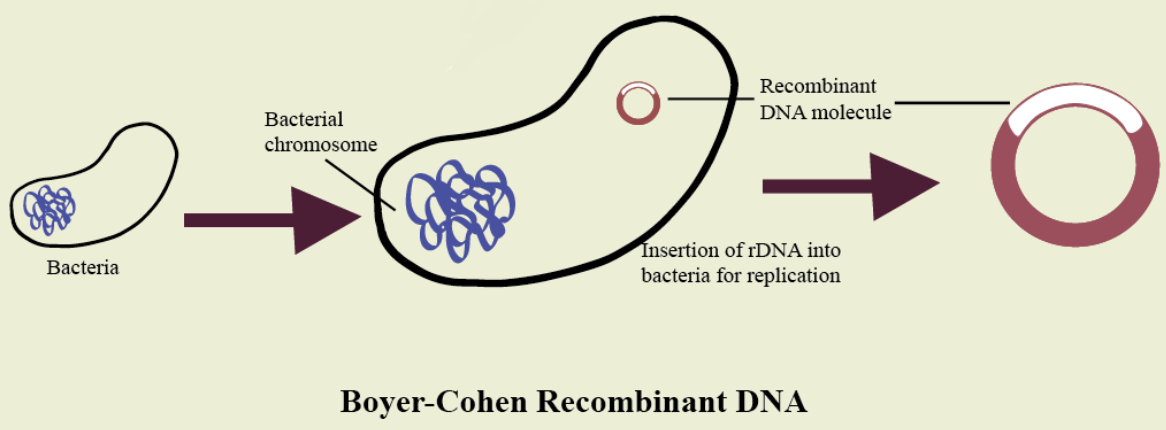
Explain the work carried out by Cohen and Boyer that contributed immensely to biotechnology.
Answer
492.9k+ views
1 likes
Hint: In 1973, Stanley Cohen and Herbert Boyer created what would be one of the first experiments in genetic engineering. A remarkable discovery in the field of biotechnology was their work. This was the mechanism that creates identical people.
Complete step by step answer:
One of the first genetic engineering experiments was conducted by Stanley Cohen and Herbert Boyer in 1972. The DNA cloning method was invented by them. Cohen developed a technique to remove plasmids from the cell and then reinsert them into other cells. Boyer and Cohen were able to recombine segments of DNA into desired configurations by combining this procedure with that of DNA splicing and injecting the DNA into bacterial cells, which could then serve as processing plants for unique proteins.
They showed that the gene for frog ribosomal RNA could be transferred into and expressed by bacterial cells.
They first developed a method of chemical cell transformation for Escherichia coli, and then constructed a plasmid called pSC101, which would be the vector. A single site for the restriction enzyme EcoRI and a tetracycline resistance gene was contained in this plasmid.

- To cut the frog DNA into small segments, the restriction enzyme EcoRI was used. Next, with the plasmid, which had also been cleaved with EcoRI, the frog DNA fragments were fused. They aligned themselves with the sticky ends of the DNA segments and were then joined together using DNA ligase.
- Then the plasmids were transferred to an Escherichia Coli strain and plated onto a tetracycline- containing growth medium. The cells incorporating the plasmid carrying the gene for tetracycline resistance grew and formed a bacterial colony. Some of these colonies were cells carrying the gene for frog ribosomal RNA. Then the scientists tested the colonies that formed for the presence of frog ribosomal RNA after development.
Note: The term clone, coined by Herbert J. Webber, is derived from the word "twig" in Ancient Greek, referring to the method by which a new plant can be formed from a twig. Cloning is the method of creating individuals, either naturally or artificially, with identical or nearly identical DNA. In nature, many species create clones through asexual reproduction. Cloning refers to the method of making clones of organisms or copies (molecular cloning) of cells or DNA fragments.
Complete step by step answer:
One of the first genetic engineering experiments was conducted by Stanley Cohen and Herbert Boyer in 1972. The DNA cloning method was invented by them. Cohen developed a technique to remove plasmids from the cell and then reinsert them into other cells. Boyer and Cohen were able to recombine segments of DNA into desired configurations by combining this procedure with that of DNA splicing and injecting the DNA into bacterial cells, which could then serve as processing plants for unique proteins.
They showed that the gene for frog ribosomal RNA could be transferred into and expressed by bacterial cells.
They first developed a method of chemical cell transformation for Escherichia coli, and then constructed a plasmid called pSC101, which would be the vector. A single site for the restriction enzyme EcoRI and a tetracycline resistance gene was contained in this plasmid.

- To cut the frog DNA into small segments, the restriction enzyme EcoRI was used. Next, with the plasmid, which had also been cleaved with EcoRI, the frog DNA fragments were fused. They aligned themselves with the sticky ends of the DNA segments and were then joined together using DNA ligase.
- Then the plasmids were transferred to an Escherichia Coli strain and plated onto a tetracycline- containing growth medium. The cells incorporating the plasmid carrying the gene for tetracycline resistance grew and formed a bacterial colony. Some of these colonies were cells carrying the gene for frog ribosomal RNA. Then the scientists tested the colonies that formed for the presence of frog ribosomal RNA after development.
Note: The term clone, coined by Herbert J. Webber, is derived from the word "twig" in Ancient Greek, referring to the method by which a new plant can be formed from a twig. Cloning is the method of creating individuals, either naturally or artificially, with identical or nearly identical DNA. In nature, many species create clones through asexual reproduction. Cloning refers to the method of making clones of organisms or copies (molecular cloning) of cells or DNA fragments.
Recently Updated Pages
Master Class 11 Economics: Engaging Questions & Answers for Success

Master Class 11 Business Studies: Engaging Questions & Answers for Success

Master Class 11 Accountancy: Engaging Questions & Answers for Success

Master Class 11 English: Engaging Questions & Answers for Success

Master Class 11 Computer Science: Engaging Questions & Answers for Success

Master Class 11 Maths: Engaging Questions & Answers for Success

Trending doubts
Which one is a true fish A Jellyfish B Starfish C Dogfish class 11 biology CBSE

State and prove Bernoullis theorem class 11 physics CBSE

1 ton equals to A 100 kg B 1000 kg C 10 kg D 10000 class 11 physics CBSE

In which part of the body the blood is purified oxygenation class 11 biology CBSE

One Metric ton is equal to kg A 10000 B 1000 C 100 class 11 physics CBSE

Difference Between Prokaryotic Cells and Eukaryotic Cells




